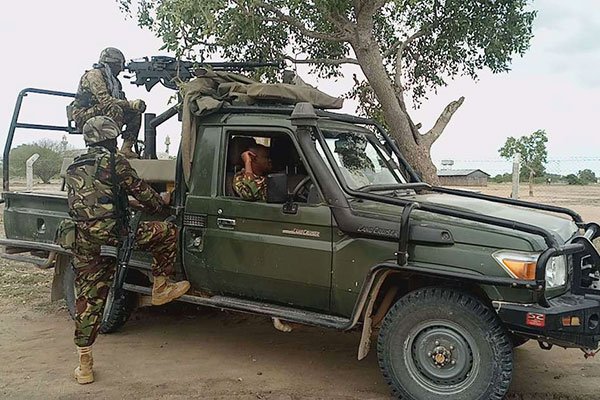
By AGGREY MUTAMBO
The kidnapping of two Cuban doctors last week in the northern Kenyan county of Mandera raises fresh questions on the approach of the Kenya Defence Forces in the pursuit of Somali militant group Al Shabaab.
Suspected Shabaab militants abducted Dr Assel Herera Correa, a physician, and Dr Landy Rodriguez, a surgeon, Cuban medical expatriates working in Kenya under a special arrangement between Havana and Nairobi.
The kidnapping happened during the day as the medics were being driven to work by a local driver and armed police. One policeman was shot dead during the abduction.
The kidnapping, directly linked to Al Shabaab, happened nearly eight years since KDF entered Somalia in October 2011, to respond to a series of kidnapping of foreigners by suspected Al Shabaab operatives in Kenya.
Criminal incidents
On Thursday, Kenya’s Foreign Affairs Cabinet Secretary Monica Juma dismissed the association of the incidents as false, arguing that isolated criminal incidents cannot dent Kenya’s pursuit of the Somalia-based militants.
“Abductions are not Kenyan-specific and the truth of the matter is that this notion about: ‘There was abduction in 2010 and therefore we are back in 2010…’ Is a very spurious linkage,” she said during the quarterly press briefing in Nairobi.
“This has happened. It is a criminal offence, it is unacceptable and it will be dealt with as such. I don’t think we are back there, back where? We cannot allow abductions to be a way of lives.
“Our objective is to protect the territorial integrity of our country. That also means protecting the life of the people on our territory.
Mandera elders were reportedly engaging their counterparts in Somalia to negotiate the release of the medics.
But Dr Juma did not divulge what exactly the government was doing, only indicating everything would be done to secure their freedom.
Abductions
Shortly before the KDF ventured into Somalia, a number of kidnappings had happened.
A British woman, Judith Tebbutt, was kidnapped in Lamu and her husband shot dead in September of that year. She would spend six months in captivity before she was released.
A French woman with disability, Marie Dedieu, was also kidnapped in October of 2011. She died in captivity after Al Shabaab denied her medication.
It was followed by another kidnapping of two aid workers for charity group MSF, from Dadaab’s IFO II Camp in October 2011.
Montserrat Serra and Blanca Thiebaut, both Spanish, would stay in captivity for two years. Al-Shabaab, at the time denied role, but the fact that detainees were ferried to Somalia after capture weakened their line of defence.
Now a part of the African Union Mission in Somalia, the KDF’s unprecedented entry into Somalia was initially to protect Kenya’s borders from Al Shabaab.
Since it embedded with Amisom in 2012, it has helped liberate most of Somalia’s southern areas bordering the Kenya.
But some experts think it exposed its own territory.
“They have been there for years, but it feels like they failed to secure our border. Al Shabaab isn’t yet defeated militarily and that just shows where we failed,” said Abdiwahab Sheikh Abdi, an analyst with Horn of Africa think-tank Southlink Consultants in Nairobi.
“I think there are several reasons. One is failure to win over local communities because most locals in Somalia believe KDF sides with one clan. There is a need to be seen as a protective force rather than an occupying one,” he said.
There is also that accusation Amisom, co-ordination is poor. Under the rules of engagement, Amisom though technically a peacekeeping force is also a combat force.
It is the largest UN-endorsed force at 22,000 troops from Kenya, Djibouti, Burundi, Uganda and Ethiopia.
Troop withdrawal
With reduced funding, the troop contributing countries like Kenya have recently tactically withdrawn ground forces from certain areas, leaving the US to target militants with drones.
Last week, Kenya’s Foreign Principal Secretary Macharia Kamau said the war on terror will require continuous support from the international community, arguing it is expensive.
“Let’s us all remember that when Kenya went into Somalia, it was a unilateral reaction of the Republic of Kenya. This is because we recognised that the challenge we were facing was an existential problem that made things extremely difficult for Kenya,” he told The EastAfrican.
“What we have not seen is the full commitment of the international community through the United Nations, taking on its responsibility to stabilise and bring peace and security to Somalia.
“The international community must recognise that the challenge we are facing in Somalia is not an East African one, it is a global challenge because the consequences of terrorism are global,” he added.
Reduced funding
The European Union, which used to fund most of the budget for Amisom (about Ksh20 billion ($200 million) a year, through the African Peace and Security Architecture, reduced funding by 20 per cent, citing other commitments in the Maghreb.
Though Amisom is endorsed by the UN Security Council, the UN hasn’t yet listed Al Shabaab among terror groups of the world, and often identifies it as part of Al Qaeda.
And as Amisom is composed of combat troops, rather than peacekeeping forces with blue helmets, the UN has been reluctant to finance its operations, fearing it could create a new precedent and force it to fund similar operations around the world.
Currently, the UN recompenses logistical expenditure for the troops, meaning it will pay up for spent equipment but will not cater for the operational costs of the mission.
Kenya has resisted calls from the opposition for a KDF withdrawal from Somalia after a series of Al Shabaab terrorist attacks both in Kenya and Somalia, including the El Adde, Westgate and Garissa University massacres.
Source: The East African


